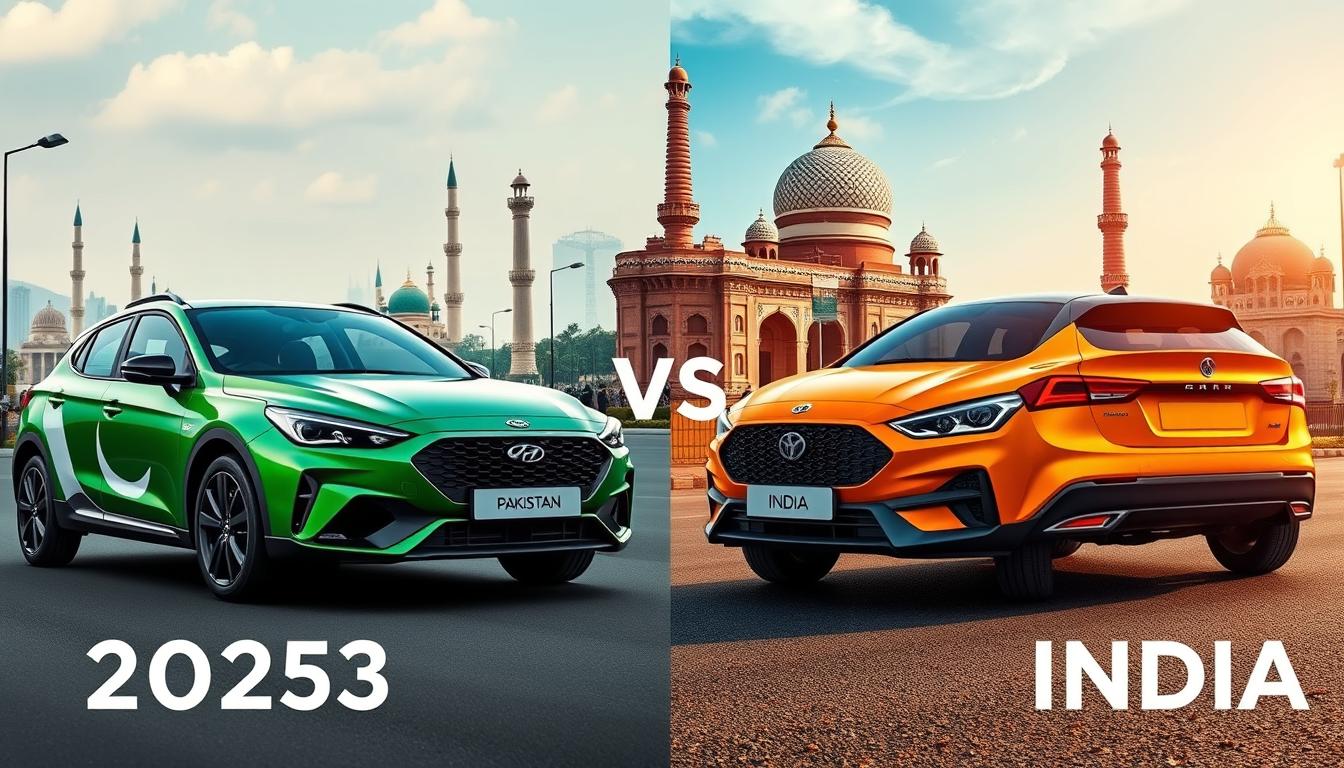As you look into buying a car in 2025, knowing the price differences in Pakistan and India is key. This article will help you understand the car markets in these countries. It will give you a clear view of the prices of different cars.
Key Takeaways
- Explore the latest automotive pricing trends in Pakistan and India
- Understand the key factors driving the car markets in both countries
- Discover the regional dynamics that influence pricing and availability
- Compare the prices of all-new 2025 car models across the two nations
- Analyze the impact of import duties and taxation on vehicle affordability
Unveiling the Latest Automotive Pricing Trends
The car market in Pakistan and India is changing fast. New car launches and cross-country price comparisons are key factors. These changes are making the market more complex and exciting.
Factors Shaping the Market
Many things affect car prices, like new tech, government rules, and local economy. Car makers keep adjusting prices to meet what buyers want. This helps them stay ahead in both Pakistan and India.
Regional Dynamics Unveiled
There are big differences in car prices between Pakistan and India. Things like how cars are made, supply chains, and import taxes matter a lot. Buyers in these countries face special price issues when choosing a car.
The car market in Pakistan and India will keep changing. Knowing the latest trends and regional differences helps everyone make better choices. This way, they can confidently move through the changing car world.
“The automotive industry is a testament to the power of innovation and adaptation. As consumer preferences and market demands continue to shift, automakers must stay agile and responsive to remain competitive.”
Pakistan’s Automotive Landscape in 2025
Looking ahead to 2025, Pakistan’s car market is set for a big change. The country is seeing more all new model 2025 car price pakistan vs india launches. This shows the fast-changing automotive industry trends at work.
Many latest vehicle launches are coming from both local and international car makers. Pakistan’s pakistan car market is getting a fresh start. People are excited to check out the newest cars that meet their needs.
There’s a big change in how people want their cars. They’re looking for better fuel efficiency, safety, and tech features. Car makers are listening, bringing in models that fit what Pakistani buyers want.
| Model | Price (Pakistan) | Price (India) |
|---|---|---|
| Honda Civic | Rs. 3.5 million | Rs. 2.8 million |
| Toyota Corolla | Rs. 4.2 million | Rs. 3.6 million |
| Suzuki Swift | Rs. 2.1 million | Rs. 1.8 million |
The pakistan car market is growing, offering a wide range of cars. There’s something for every budget and preference. The future looks bright for Pakistan’s car industry, with more choices and competition.

All New Model 2025 Car Price Pakistan Vs India
In 2025, we see a big difference in car prices between Pakistan and India. This comparison helps us understand why cars cost more in one place than the other. It shows us what affects car prices for people in both countries.
Many things influence car prices, like import duties and local costs. Also, how much people can spend on cars matters. By looking at these, we learn about future car market trends.
| Model | Pakistan Price (PKR) | India Price (INR) | Price Difference |
|---|---|---|---|
| Honda Civic 2025 | 4,000,000 | 2,500,000 | 60% higher in Pakistan |
| Toyota Corolla 2025 | 3,800,000 | 2,200,000 | 72% higher in Pakistan |
| Suzuki Swift 2025 | 2,000,000 | 1,200,000 | 67% higher in Pakistan |
The numbers show a big gap in car prices, with Pakistan’s prices being higher. This gap comes from higher import duties and manufacturing costs in Pakistan. Also, Pakistan’s market is smaller than India’s big automotive industry.
Looking at car affordability analysis, these price gaps affect how much people can buy. The all new model 2025 car price pakistan vs india comparison shows the need for solutions. It’s important for leaders to work on making cars more affordable for everyone.
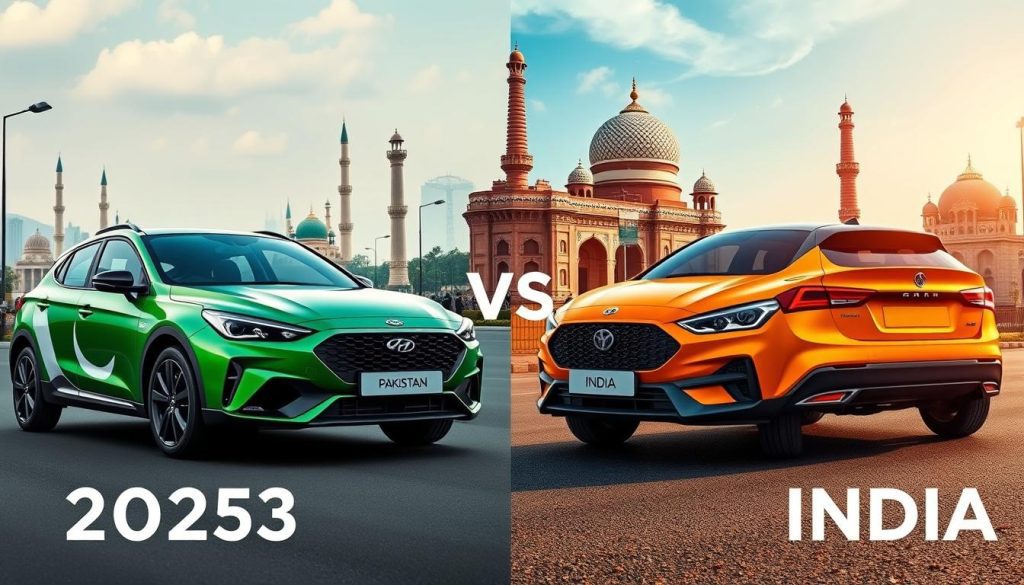
India’s Flourishing Car Market
India’s car industry has grown a lot in recent years. It’s now a big player in making cars. The indian car market has seen more latest vehicle launches. This meets the needs of more people.
At the core of this growth is India’s strong domestic production. Big car makers have set up top-notch factories all over the country. They use India’s resources and skilled workers to make many kinds of cars. These cars follow the latest automotive industry trends.
Domestic Production Powerhouse
India’s car making has hit new records. Big companies are investing more in making more cars. This helps India meet its own car needs and also send cars to other countries.
- Domestic car makers are making more cars to meet the indian car market demand.
- Top factories have been built in key places. They use India’s skilled workers and good infrastructure.
- Good supply chains and logistics have also helped the industry grow.
India’s car sector has grown thanks to new car designs, good prices, and focus on latest vehicle launches. This has made India a leader in the automotive industry trends.

“India’s car market has seen a big change. This is thanks to more car making and a drive for new ideas.”
Import Duties and Taxation: A Tale of Two Nations
Import duties and taxes greatly affect the car market in Pakistan and India. These policies shape the prices of vehicles and influence what people buy. They play a big role in both countries.
In Pakistan, the government has a complex system of duties and taxes. This makes imported cars very expensive. The goal is to help the local car industry, but it’s hard for people to find affordable cars.
India, however, has a more open approach to taxes and duties. While there are still tariffs, the government supports local car makers. This makes cars cheaper for people, compared to Pakistan.
| Comparison | Pakistan | India |
|---|---|---|
| Import Duties | High, ranging from 50% to 100% of the vehicle’s value | Moderate, typically between 20% to 50% of the vehicle’s value |
| Taxes | Extensive, including customs duty, sales tax, and additional levies | Relatively lower, with a focus on promoting domestic manufacturing |
| Price Impact | Significantly higher prices for imported vehicles | Relatively more affordable prices, especially for locally produced models |
The differences in duties and taxes between Pakistan and India affect car prices. This shapes what people buy and drives the car market in each country.

The car industry is changing in both countries. It’s important for leaders to find a balance. This could lead to better trade and benefits for everyone.
Affordable Mobility: Entry-Level Cars in Focus
The entry-level car segment is key in the car market, offering affordable choices. In Pakistan and India, there are many compact, cost-effective cars. These vehicles meet the needs of those looking for affordable ways to get around.
Budget-Friendly Options Compared
In Pakistan, the Suzuki Mehran, Yamaha Baja, and Daihatsu Cuore lead the entry-level market. They balance affordability with basic features. Prices start at around PKR 800,000 to PKR 1.2 million, making them more accessible.
In India, the entry-level car segment is also lively. Models like the Maruti Suzuki Alto, Hyundai Santro, and Tata Nano are popular. They cost between INR 3.5 lakh to INR 5.5 lakh, appealing to those who want reliable, practical cars without spending a lot.
| Entry-Level Car Models | Pakistan Prices (PKR) | India Prices (INR) |
|---|---|---|
| Suzuki Mehran | 800,000 – 950,000 | N/A |
| Yamaha Baja | 900,000 – 1,100,000 | N/A |
| Daihatsu Cuore | 950,000 – 1,200,000 | N/A |
| Maruti Suzuki Alto | N/A | 3.5 lakh – 4.5 lakh |
| Hyundai Santro | N/A | 4.5 lakh – 5.5 lakh |
| Tata Nano | N/A | 3.2 lakh – 4.0 lakh |
The car affordability analysis highlights the different pricing strategies in Pakistan and India. Both countries offer entry-level cars for budget-conscious buyers. However, the specific models and prices show the unique needs and preferences of each market.
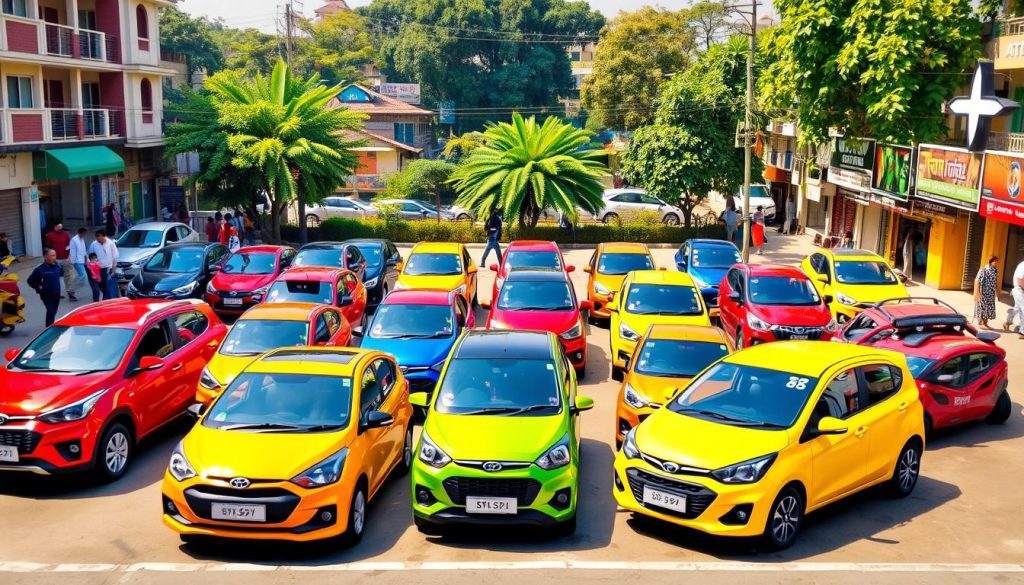
Mid-Range Marvels: Balancing Cost and Features
The mid-range car segment in Pakistan and India is booming. It offers great value for those who want quality without spending too much. These cars are affordable and packed with features.
In the Pakistan car market, the Honda Civic and Toyota Corolla are top picks. They offer a mix of affordability and quality. You get a comfy ride, reliable performance, and lots of extras.
In India, the Maruti Suzuki Ciaz and Hyundai Verna are favorites. They have good handling, save fuel, and come with cool tech. They’re perfect for those who want value and features.
| Model | Price in Pakistan (PKR) | Price in India (INR) | Key Features |
|---|---|---|---|
| Honda Civic | 3,500,000 – 4,500,000 | 1,800,000 – 2,500,000 | Spacious cabin, advanced safety tech, turbocharged engine options |
| Toyota Corolla | 3,000,000 – 4,000,000 | 1,700,000 – 2,300,000 | Renowned reliability, comfortable ride, efficient engine lineup |
| Maruti Suzuki Ciaz | N/A | 850,000 – 1,200,000 | Elegant design, spacious interiors, fuel-efficient engines |
| Hyundai Verna | N/A | 950,000 – 1,500,000 | Sophisticated styling, advanced connectivity features, strong performance |
Comparing prices, Indian mid-range cars are often cheaper than those in Pakistan. This is due to import duties, taxes, and production scales.
The mid-range segment in both countries is a great deal. It meets the needs of those who want quality without breaking the bank. As these markets grow, these cars will keep shaping the car scene.
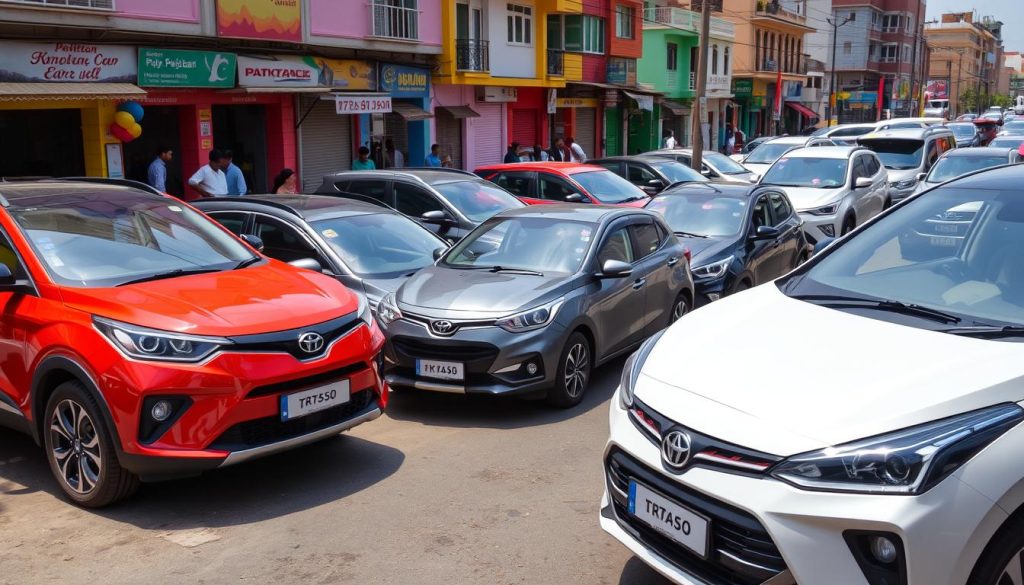
Luxury Unleashed: Premium Segment Analysis
The premium car segment in Pakistan and India has seen big changes. Now, there are many exclusive cars for those who want the best. These include sleek sportscars and luxurious sedans, showing the top of car design and engineering.
Exclusive Offerings and Pricing Strategies
In the luxury car world, Pakistan and India have more premium models than ever. These cars are all about style, comfort, and performance. They are made for those who want the best driving experience.
The prices of these luxury cars reflect their exclusivity and prestige. Things like advanced technology, new features, and top-notch craftsmanship make them more expensive. This sets them apart from regular cars.
| Model | Pakistan Price | India Price |
|---|---|---|
| Mercedes-Benz S-Class | $110,000 | $95,000 |
| BMW 7 Series | $90,000 | $85,000 |
| Audi A8 | $100,000 | $92,000 |
| Lexus LS | $95,000 | $88,000 |
This table shows how prices differ in Pakistan and India’s luxury car markets. It helps us understand what rich buyers look for in these regions.

“The pursuit of perfection is what drives the luxury car market, and manufacturers in Pakistan and India are rising to the challenge with their exclusive offerings.”
Electric Revolution: The Future of Sustainable Driving
The car industry is changing fast, with electric vehicles (EVs) leading the way. Both Pakistan and India are seeing more EVs on the road. This is because people want to drive in a way that’s better for the planet.
There are now many different EVs available, from affordable to high-end models. This shows the industry’s effort to offer green driving options for everyone.
| Feature | Pakistan EV Market | Indian EV Market |
|---|---|---|
| Charging Infrastructure | Expanding, but limited in coverage | Robust, with significant government investments |
| Incentives and Subsidies | Emerging, with some government initiatives | Comprehensive, with various tax rebates and subsidies |
| Customer Awareness | Gradually increasing, but more education needed | Relatively higher, driven by media campaigns and public awareness |
More people in Pakistan and India want to drive electric. Governments are helping with policies and incentives. And, people are learning about the good things about electric cars.
The electric car movement is getting stronger. The car industry in Pakistan and India will be key in making driving greener. With better tech, more charging spots, and good policies, EVs will grow a lot. This will help make our future cleaner and more sustainable.
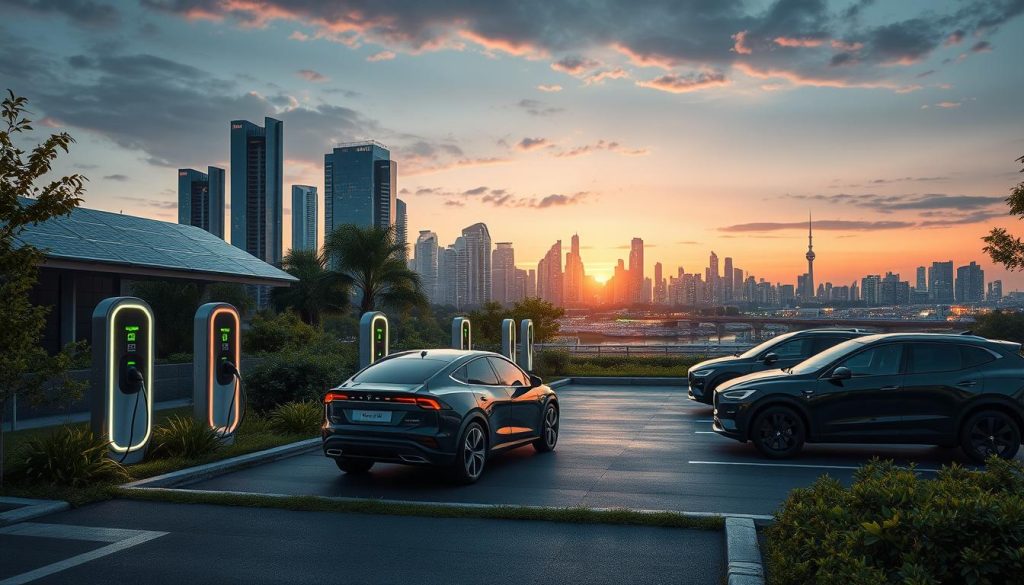
Consumer Purchasing Power: A Decisive Factor
In Pakistan and India, how much people can spend on cars matters a lot. Knowing what people earn and how they spend helps us see who can buy cars. This is key to understanding the car market.
Disposable Income Analysis
In Pakistan, people’s disposable income has gone up. This means they have more money to spend on cars. But, many still can’t afford basic cars, especially in the Pakistan car market.
In India, things are different. The middle class is growing, and so is how much people can spend. This has led to more people wanting cars, from cheap to expensive ones. This has made car makers work harder to stand out.
“The ability of consumers to purchase cars is not solely determined by the sticker price but also by their overall consumer purchasing power and financial flexibility.”
As car markets in Pakistan and India change, knowing about disposable income and car affordability analysis is key. Car makers need to adjust their plans to meet the needs of more buyers.

Automotive Industry Trends Shaping the Market
The car market in Pakistan and India is changing fast. New trends and innovations are making a big impact. These changes include electric vehicles and a focus on what customers want.
Electric cars are becoming more popular. People want cars that are good for the environment, thanks to government help. Car makers are now offering more electric models.
This change is not just about cars. It’s also changing how people think and what they need. It’s making car makers work harder to meet these needs.
| Trend | Impact on Pakistan Car Market | Impact on Indian Car Market |
|---|---|---|
| Electric Vehicles | Gradual adoption, government incentives, and infrastructure development | Rapid growth, diverse EV models, and expanding charging network |
| Latest Vehicle Launches | Increased consumer demand for modern features and technology | Fierce competition among automakers to meet evolving consumer preferences |
| Personalized Preferences | Automakers tailoring products to cater to diverse customer needs | Emphasis on customization and personalization options |
The future of cars in Pakistan and India looks exciting. Car makers are working hard to keep up with new trends. They want to meet the changing needs of their customers.

“The automotive industry is on the cusp of a new era, driven by the convergence of electrification, automation, and shifting consumer preferences. Staying ahead of these trends will be crucial for manufacturers to succeed in the Pakistani and Indian car markets.”
Cross-Border Trade and Collaborations
The automotive world is changing fast. Pakistan and India could work together better. This could lead to new ideas and growth.
Leveraging Regional Strengths
Pakistan is known for making cars well. It has great factories and workers. India, on the other hand, is known for its tech and engineering. Working together, they could make better cars for everyone.
They could share knowledge and new ideas. This could make cars more efficient and affordable. It would meet the needs of people in both countries.
| Key Benefits of Cross-Border Collaborations | Pakistan | India |
|---|---|---|
| Manufacturing Capabilities | ✓ | |
| Technological Advancements | ✓ | |
| Shared Technological Innovations | ✓ | ✓ |
| Expanded Market Opportunities | ✓ | ✓ |
Pakistan and India’s work together could change the car world. It will help the pakistan car market and indian car market. The automotive industry trends in this area are set for a big change.
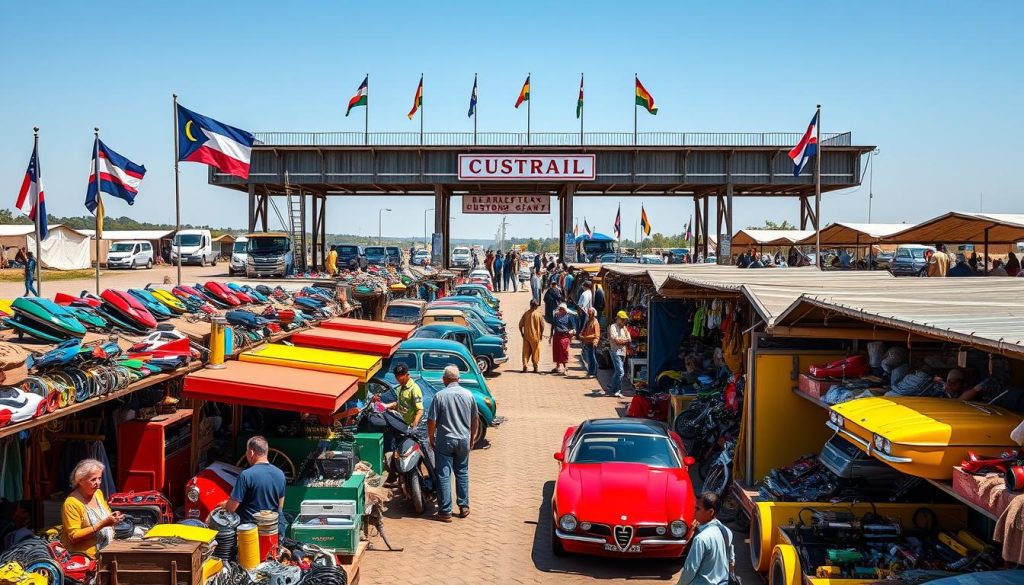
Localization Strategies: Tailoring for Success
The car markets in Pakistan and India are growing fast. Automakers are now focusing on localization to keep up and meet local needs. They’re making their products and services fit the local market, which helps them grow and bring new ideas to car buyers.
Adapting car designs to fit local tastes and driving conditions is key. Companies study what people want in Pakistan and India. Then, they make cars that look good and work well in local traffic.
Optimizing production to use local resources is also important. Automakers are working with local suppliers and using domestic production facilities. This makes cars cheaper and helps the Pakistan and Indian car market grow.
Companies are also changing how they sell and service cars to fit local needs. They offer special financing and have good service networks. This makes sure customers are happy, which helps the companies grow.
By focusing on localization, car makers in Pakistan and India are meeting their customers’ needs. This will help them succeed in these changing markets. As new cars come out, we’ll see how these efforts make the industry better for everyone.

Emerging Technologies: Redefining the Driving Experience
In Pakistan and India, the car world is changing fast. New tech like self-driving cars and better connectivity is coming. These changes aim to make driving safer and more fun.
Autonomous driving is a big deal. Companies in both countries are working hard on it. Self-driving cars could make cities safer and easier to get around.
Connectivity is also key. Cars now have cool features like traffic updates and voice control. These make driving more enjoyable and help us stay connected on the road.
There’s a big push for green cars too. Electric vehicles are becoming popular, thanks to government help and new models. This shift is good for the planet and uses new tech.
“The future of transportation is electric, autonomous, and connected. These emerging technologies will redefine the driving experience and reshape the automotive industry in Pakistan and India.”
But, there are hurdles to overcome. Rules, infrastructure, and getting people to accept new tech are big challenges. Still, the car world in Pakistan and India is ready to take on these changes.

The car market in both countries is changing fast. These new tech features will make driving safer and more fun. The industry is working hard to meet today’s needs.
Conclusion
This deep dive into 2025 car prices in Pakistan and India has given us key insights. We looked at what shapes the car markets, the role of import duties and taxes, and new trends. This helps us understand the car buying experience in both countries.
As the all new model 2025 car price pakistan vs india scene changes, this article is a great guide. It covers 2025 car models with new tech and features. It also breaks down automotive pricing and the markets in Pakistan and India. This helps you make smart choices when buying a car.
This study covers everything from latest vehicle launches to automotive industry trends. It gives a full picture of what affects car prices. Whether you’re looking at affordable cars or luxury models, the info here is very useful. As car prices and rules change, this article will keep helping you make good car choices.
FAQ
What are the key factors that shape the automotive markets in Pakistan and India?
Several factors influence the car markets in Pakistan and India. These include import duties, local production, and consumer trends. These elements affect prices and competition between the two countries.
How do the 2025 car prices in Pakistan compare to those in India?
Car prices in 2025 will differ between Pakistan and India. This is due to import duties, production costs, and consumer spending power. Our analysis compares the latest car prices in both markets.
What are the key trends shaping the automotive industry in Pakistan and India?
The car industry in Pakistan and India is changing fast. Electric vehicles, connected tech, and new consumer tastes are leading the way. These changes are transforming driving and the market in both countries.
How do the entry-level and mid-range car segments compare between Pakistan and India?
Entry-level and mid-range cars are key in Pakistan and India. They make cars more affordable and accessible. Our analysis looks at these options, their features, and how they meet consumer needs.
What is the impact of import duties and taxation on car prices in Pakistan and India?
Import duties and taxes greatly affect car prices in Pakistan and India. Our article discusses how these policies differ and impact prices in each market.
How does the consumer purchasing power and disposable income affect car affordability in Pakistan and India?
Buying power and income are crucial in Pakistan and India. Our analysis looks at income levels and spending habits. It shows how these factors influence car affordability and demand.
What are the key localization strategies employed by automakers in Pakistan and India?
Automakers in Pakistan and India tailor their products to local tastes. Our article explores these strategies. It shows how they help the car industry succeed in each country.

